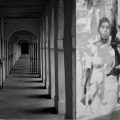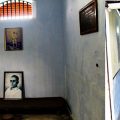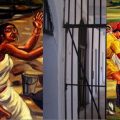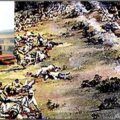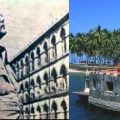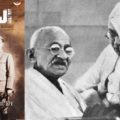Andaman Cellular Jail: How Torture and Trauma of Freedom Fighters are Forgotten
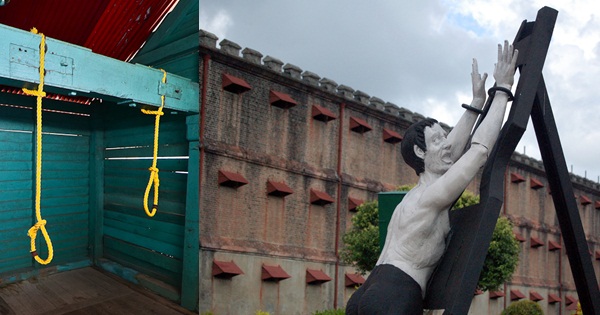
Every year, on 15th August the Tricolor is hoisted by our Prime Minister from the ramparts of the Red Fort. It is an annual ritual telecast live every year in our living rooms and has been for so long that it seems to have little connection to the freedom our ancestors fought for. It has become more of a political statement by the Prime Minister of whichever party is in power.
For generations, Indians were given the message that they got their independence from the British on this particular day through the efforts of Mahatma Gandhi and Jawahar Lal Nehru with a few more men and women added in the background who also helped. The image of Red Fort with the flag fluttering in the air became synonymous with our idea of freedom relegating all other images to the background. It has become so imprinted on our psyche that the sequence where the Prime Minister climbs on to the rampart and addresses the nation about preserving our freedom has become banal.
The audience in Red Fort ground consisting of school children, bureaucrats and dignitaries some of whom are more out of compulsion, has little if any connection to India’s tragic road to freedom. One doesn’t see any freedom fighters or hear them there. Red Fort doesn’t have any association with freedom struggle like many others have, where the blood and cries of freedom fighters mixed together. It doesn’t have a history written in blood. There were never any hangings or mass torture of freedom fighters like in Andaman. Shahnawaz Khan, Dhillon and Prem Sehgal from the INA were tried there for treason and that is the only association many can think of. However, nowhere inside the place one feels the air charged with the cries of those who lost their lives for our freedom.
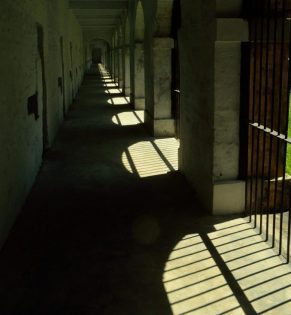
Dark isolated cells in Andaman cellular jail; Image courtesy: lakshmisharath.com
Far away from this hot spot, some of the freedom fighters of India and their descendants have been assembling quietly in a ceremony little known to the world outside. It is not only more heartfelt and has a simplicity that is unmatched but I believe has a message that no other place has. While we have come to associate our independence with flag hoisting at Red Fort, another event far away stands as a silent and mute symbol to the spirit of nobility and courage that our freedom fighters showed in countering the terror of the British. If the freedom fighters had failed, the British would have been on Indian soil for many more years. The fact they lost taught them a lesson they were never to forget.
Red Fort, more of a glamorous tourist spot today, doesn’t have the same emotional air that reminds us of the sacrifices of our freedom fighters like it does at Andaman Cellular Jail. A time may come when even that will be gone leaving us to believe it never existed. Nehru tried to demolish it for this reason.
That is why thousands of miles away from Red Fort in Andaman Cellular Jail, a group of men and women have been quietly holding a silent vigil every year on this day in the memories of their fathers and for all revolutionaries. They don’t want them to be forgotten even if rest of the country has forgotten them. As their group leader told me, it was the courage of their fathers that led the British to concede that their policy of terror and mass torture was a failure and wouldn’t be able to subjugate Indians. A little known event known as ‘the hunger strike of the prisoners’ twice in the thirties taught the British that the spirit of the revolutionaries couldn’t be crushed. It was the beginning of a realization that they were against an enemy who could counter their terror with a counter terror, as in the words of Mr. Anup Dasgupta. The British carefully hid it and admitted it many years later when the Ex British Prime Minister Atlee admitted so in Calcutta.
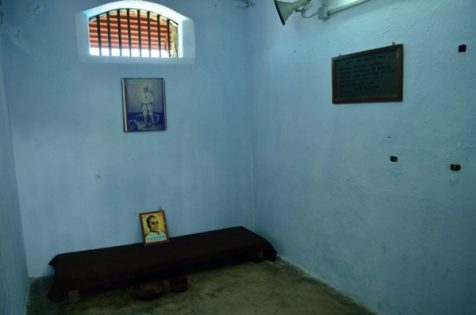
Cell of Veer Savarkar; Image courtesy: lakshmisharath.com
“Why do you come to Andaman Cellular Jail every year on 15th August?” I had asked Mr. Anup Dasgupta, the octogenarian team leader of a delegation of men and women whose parents were incarcerated in the Cellular Jail.
“To keep alive the memories of the revolutionaries of the jail so that they are not forgotten. They faced the British terror with counter terror with nothing but their arms raised to the British guns. This spirit, this story of theirs spread and led and an average Indian to believe that he could face the British with bare hands. No other group faced the terror like they did, least of all Gandhi or any Congressman. They could see the average man borrowing this spirit from the revolutionaries.”
“Why didn’t anybody admit it?” I wonder. “Why did the British commit so much torture and terror when it was not necessary?”
“The British were scared of them. Not of anyone else. They knew if their spirit begins to spread to the hearts of Indians they will lose the country. About Congress and their leaders, they were not scared. The Andaman Cellular Jail referred to as ‘Kalapani’ or India’s Bastille where political prisoners and revolutionaries were lodged after they revolted against the British. The British responded by creating a prison that would strike a permanent terror in the hearts of Indians to contain it. In that respect Andaman was different from other prisons. Not only it would be the cruelest but would terrorize and traumatize everyone.”
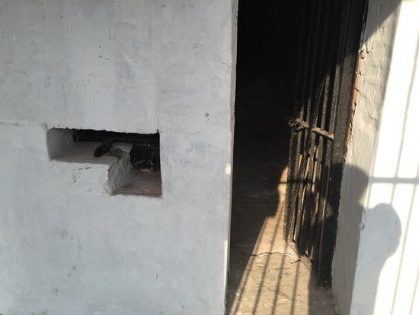
Cellular Jail room; Image courtesy: tripadvisor
“The revolutionaries knew it then.”
“Yes,” he answered. “I remember my father saying to me that once there, they realized they had to behave in a way so that the British never feel they have been able to crush their soul. If they felt so, they would have advertised it as a success. They could never do that to our fathers and only then the Indian people knew that the revolutionaries didn’t give in to torture.”
“So, perhaps they fought a bigger battle from inside as from the outside.”
“Yes, you may say that,” he said.
“In the entire literature on Andaman, I have not found any prisoner’s spirit broken by torture. How did they manage to stay calm inside despite the torture? Who gave them the strength? My father was incarcerated in the jail for five years and he lived for a short time after his release. The torture had damaged his inner organs that he couldn’t sustain himself for long. Like many others who went along with him.”
“Why was he released?”
“They forced a release from the prison after they began a hunger strike for their rights and chose to die instead of being force fed. The British tried to force feed them through pipes to keep them alive till they realized they were killing them in the ensuing process. That they were not able to keep them alive at a sub-human level which was their mission, they realized the prisoners had shown them they had a choice to live their life their way. That they couldn’t take away their choice, their ultimate freedom.”
“And this realization that they can’t subdue their spirit was a fatal blow to the British idea of domination of Indians.”
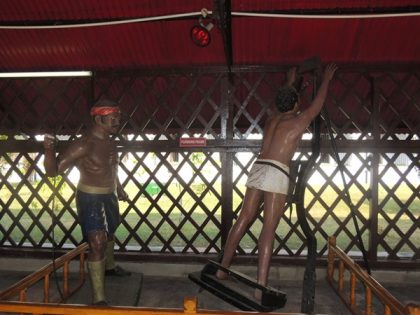
Andaman Cellular Jail; A glimpse of how freedom fighters were tortured; Image courtesy: Firefly Daily
The prisoners couldn’t talk to each other but they learnt to communicate through their eyes and body language and the message was ‘they won’t be able to crush our spirit’. They passed it to each other.”
“And the British got to know of it.”
“Yes, my father told me,” he added with an ironic smile. “But it is not to be found in history textbooks and it gets erased with every passing year.”
Mr. Anup Dasgupta spoke in a halting voice and took some time to answer as I talked to him. A man, otherwise shy and quiet, had a fire in him that is seen in the children of revolutionaries. When he burst out, it was with a passion and rage that came straight from his heart.
“They, the British, gave us a cause to be angry and one which we have never erased. It comes out in our voice even now. We will never let it die till our last breath and then pass it on.”
“What is the source of this anger?”
“The anger comes out at the very thought of what they did to my father,” he replied.
“Is the anger only with the British?”
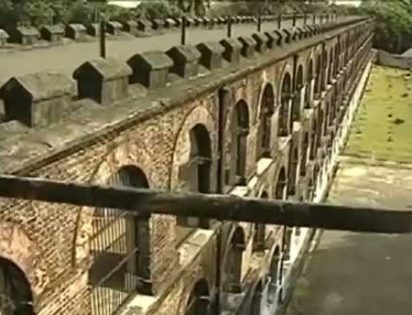
Andaman Cellular Jail; Image courtesy: YouTube
“There is another anger at Congress, at Gandhi and Nehru and all congress leaders who tried to denigrate their memory. The anger is at the injustice where the stories of our fathers doesn’t find its mention in the annals of history.”
“Your anger, I have never seen in a Gandhian or their descendants,” I answered.
“You won’t see it either,” one of the group members listening to our conversation said. “Gandhians were not sent to Andaman. It was an unwritten policy of the British. It was an oral understanding of two brothers in arms. The British considered Gandhi and Nehru as their pawns, on their side. How could they send them or anyone from their group to this inhuman place? If sent here and tortured, they would have seen the futility of the non-violent struggle and its hypocrisy. It is only those who understood that the British can only be thrown out by taking up arms.”
“The voice of those died here, we won’t let it die. That is why we come here every year to speak.”
“Ever since our independence in 1947, an attempt has been made to undermine the history of our fathers and all revolutionaries who breathed their last here. Our attempt is to see that the history of our fathers is not erased by the Government for future generations. Do you know after Independence, Nehru wanted to destroy the Cellular Jail and build a hospital? Would he have thought of doing so on his own? He, his mentors and his sycophants saw Andaman as a threat to his hegemony, the legacy of the Congress. He knew that if Andaman remains as a prison, the story of Congress having got India freedom will crumble one day. Nehru managed to destroy four out of seven buildings. He had to stop when we threatened with mass action.”
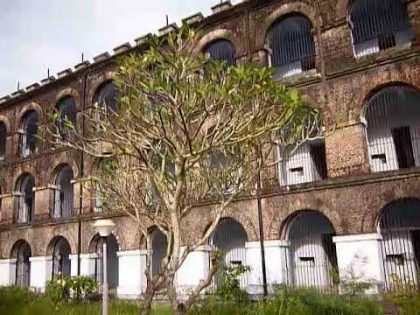
Andaman Cellular Jail; Image courtesy: YouTube
I could only nod in silence. There will remain an eternal conflict between what Cellular Jail represents as a symbol to our national conscience and how different it is from what the court historians of our country have tried to project. Will a day come, sooner than later, when the version of history planted upon us will not last and let the truth emerge.
The past few days, a visit to Andaman had been a poignant one. I had noticed a subtle, insidious attempt at every step to undermine this part of India’s freedom struggle and project it as an add-on to the movement by the Congress.
“Do you know several years ago, an attempt was made to put up a picture of Gandhi and Nehru in Cellular Jail by the administration. On hearing this, we decided to sit on a fast until death in the jail till the decision is reversed. Fearing an outrage across the nation, it was reversed,” Mr. Dasgupta burst out, his voice burning with anger and desperation.
“Why did you not agree to that? Some would say it was only a photograph,” I asked.
“No. Did they play any role here? Did they ever come here? They, their congress colleagues were they sent here to be tortured? None of them were threatened or killed. Gandhi never said a word against the inhuman practices here on the inmates. He did only after Tagore spoke up. Gandhi’s thinking was so much in line with the British. They thought that these revolutionaries were the real danger, sub humans who should be wiped out through torture. Gandhi, Nehru kept a stoic silence about that, especially Gandhi who believed that these inmates are his rivals and deserved to be killed. Could any ruler have asked for more from Gandhi?”
“The sound and light show there is another injustice. It doesn’t bring in fully the torture and violence enacted daily on the prisoners. The daily schedule in Cellular jail was worse than that of a concentration camp and the torture unparalleled,” he continued. “It could beat any other torture chamber of those times in the torture inflicted on the prisoners, my research tells me,” he added. “The torture was most grotesque, brutal and could put the concentration camps of the next decades to shame. Yet the overall impression given today is that the torture was just like any other prison, shown in a minimalistic way, almost in passing. When I asked someone why the degree of torture shown doesn’t match the actual description that one finds in memoirs of the people, he said people get affected so it’s kept a minimal.”
“The core program of the Cellular Jail was only torture. The jail was built with that purpose in mind. That every prisoner should go through it and every Indian should hear about it. The very ideology was to torture the Indian revolutionaries so brutally that they remain traumatized and their stories affect every youth on the mainland. It was a psychological warfare designed carefully for Indians. It was felt that this jail will prevent every young Indian of revolting against the British Empire for another hundred years. Ironically, as the stories reached the shores, it had the opposite effect from what the British had anticipated. The prisoners not only bore it on their bodies and learnt to not give in to the suffering. It was a collective effort on their part to show that they could not be cowed down even without any meeting ever. My father used to say that even though we were not allowed to meet, we connected with each other in the jail in a spiritual way and never felt alone.”
“Do you know it was Rabindra Nath Tagore who first called a meeting to protest against the torture in the Cellular Jail? When it almost seemed to take the shape of a movement larger than his own, Gandhi, to keep his movement relevant, issued an appeal that he would take up their cause. He asked them to give up their hunger strike that greatly helped the British. Did Gandhi ever stop any hunger strike elsewhere? How would it be if he were force fed?”
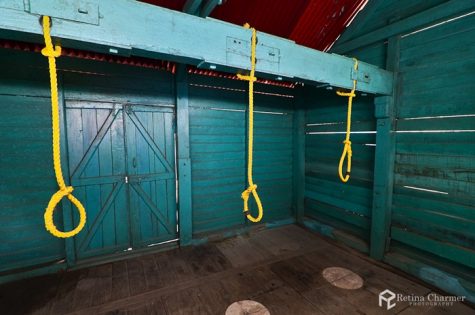
Gallows Inside Cellular Jail; Image courtesy: Retina Charmer Photography
On this eve of Independence Day, as I sat not aware of the time, dusk began to fall throwing a strange light on the walls of different cells where the prisoners once spent their days dreaming of a free India.
Many of them stayed just above the hanging room. As I looked at it one final time before leaving, a thought came to me that the inmates of Andaman Cellular Jail represented the very inviolate spirit of those Indians who spread that spirit in India in a time most needed and one that the British could not crush. A hundred years ago, those men and women made it sure living in lonely cells that they won’t give up even facing death and their stories of courage reach every individual on the mainland who would be keenly watching. It was a spirit that the British came to fear and later movements used as they multiplied. But do we know about this today? Will it not get erased at the cruel hands of history if we don’t stand up for them? Will it be able to stay alive after these children of freedom fighters leave this world? Will the later generations be able to keep it alive? I pray from my heart that we do.
Note by Author – The above article was written after a discussion with some of the children and grandchildren of those whose parents were incarcerated in Andaman Cellular Jail and who come every year on 15th August to honor their memories. This article couldn’t have been possible without their support.
Featured image courtesy: fotocommunity.
Dr. Rajat Mitra
Latest posts by Dr. Rajat Mitra (see all)
- Sengol: Rebuilding History with the Sacred Symbol - October 23, 2024
- Will the ‘Veer Bal Divas’ Usher a New Era for India? - October 23, 2024
- Dogs and British Empire; A Legacy Followed Till This Day - October 23, 2024

